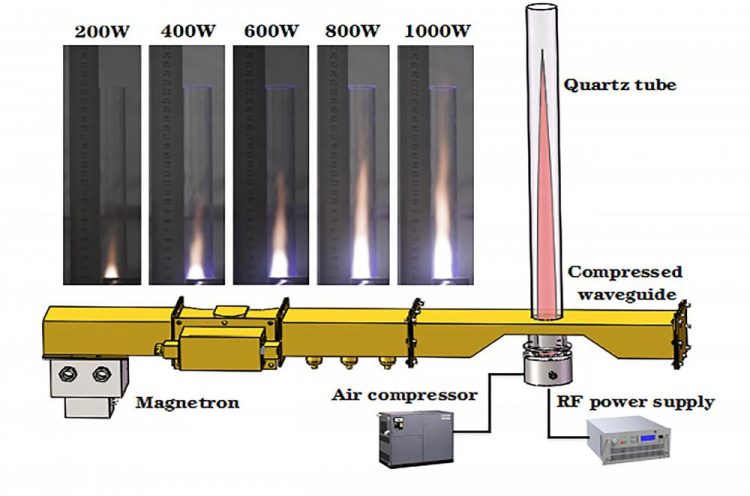Fossil fuel-free jet propulsion with air plasmas

A schematic diagram of a prototype microwave air plasma thruster and the images of the bright plasma jet at different microwave powers. This device consists of a microwave power supply, an air compressor, a compressed microwave waveguide and a flame ignitor. Credit: Jau Tang and Jun Li
Humans depend on fossil fuels as their primary energy source, especially in transportation. However, fossil fuels are both unsustainable and unsafe, serving as the largest source of greenhouse gas emissions and leading to adverse respiratory effects and devastation due to global warming.
A team of researchers at the Institute of Technological Sciences at Wuhan University has demonstrated a prototype device that uses microwave air plasmas for jet propulsion. They describe the engine in the journal AIP Advances, from AIP Publishing.
“The motivation of our work is to help solve the global warming problems owing to humans' use of fossil fuel combustion engines to power machinery, such as cars and airplanes,” said author Jau Tang, a professor at Wuhan University. “There is no need for fossil fuel with our design, and therefore, there is no carbon emission to cause greenhouse effects and global warming.”
Beyond solid, liquid and gas, plasma is the fourth state of matter, consisting of an aggregate of charged ions. It exists naturally in places like the sun's surface and Earth's lightning, but it can also be generated. The researchers created a plasma jet by compressing air into high pressures and using a microwave to ionize the pressurized air stream.
This method differs from previous attempts to create plasma jet thrusters in one key way. Other plasma jet thrusters, like NASA's Dawn space probe, use xenon plasma, which cannot overcome the friction in Earth's atmosphere, and are therefore not powerful enough for use in air transportation. Instead, the authors' plasma jet thruster generates the high-temperature, high-pressure plasma in situ using only injected air and electricity.
The prototype plasma jet device can lift a 1-kilogram steel ball over a 24-millimeter diameter quartz tube, where the high-pressure air is converted into a plasma jet by passing through a microwave ionization chamber. To scale, the corresponding thrusting pressure is comparable to a commercial airplane jet engine.
By building a large array of these thrusters with high-power microwave sources, the prototype design can be scaled up to a full-sized jet. The authors are working on improving the efficiency of the device toward this goal.
“Our results demonstrated that such a jet engine based on microwave air plasma can be a potentially viable alternative to the conventional fossil fuel jet engine,” Tang said.
###
The article, “Jet propulsion by microwave air plasma in the atmosphere,” is authored by Dan Ye, Jun Li and Jau Tang. The article will appear in AIP Advances on May 5, 2020 (DOI: 10.1063/5.0005814). After that date, it can be accessed at http://aip.
ABOUT THE JOURNAL
AIP Advances is an open access journal publishing in all areas of physical sciences–applied, theoretical, and experimental. The inclusive scope of AIP Advances makes it an essential outlet for scientists across the physical sciences. See https:/
Media Contact
More Information:
http://dx.doi.org/10.1063/5.0005814All latest news from the category: Power and Electrical Engineering
This topic covers issues related to energy generation, conversion, transportation and consumption and how the industry is addressing the challenge of energy efficiency in general.
innovations-report provides in-depth and informative reports and articles on subjects ranging from wind energy, fuel cell technology, solar energy, geothermal energy, petroleum, gas, nuclear engineering, alternative energy and energy efficiency to fusion, hydrogen and superconductor technologies.
Newest articles

Combatting disruptive ‘noise’ in quantum communication
In a significant milestone for quantum communication technology, an experiment has demonstrated how networks can be leveraged to combat disruptive ‘noise’ in quantum communications. The international effort led by researchers…

Stretchable quantum dot display
Intrinsically stretchable quantum dot-based light-emitting diodes achieved record-breaking performance. A team of South Korean scientists led by Professor KIM Dae-Hyeong of the Center for Nanoparticle Research within the Institute for…

Internet can achieve quantum speed with light saved as sound
Researchers at the University of Copenhagen’s Niels Bohr Institute have developed a new way to create quantum memory: A small drum can store data sent with light in its sonic…





















